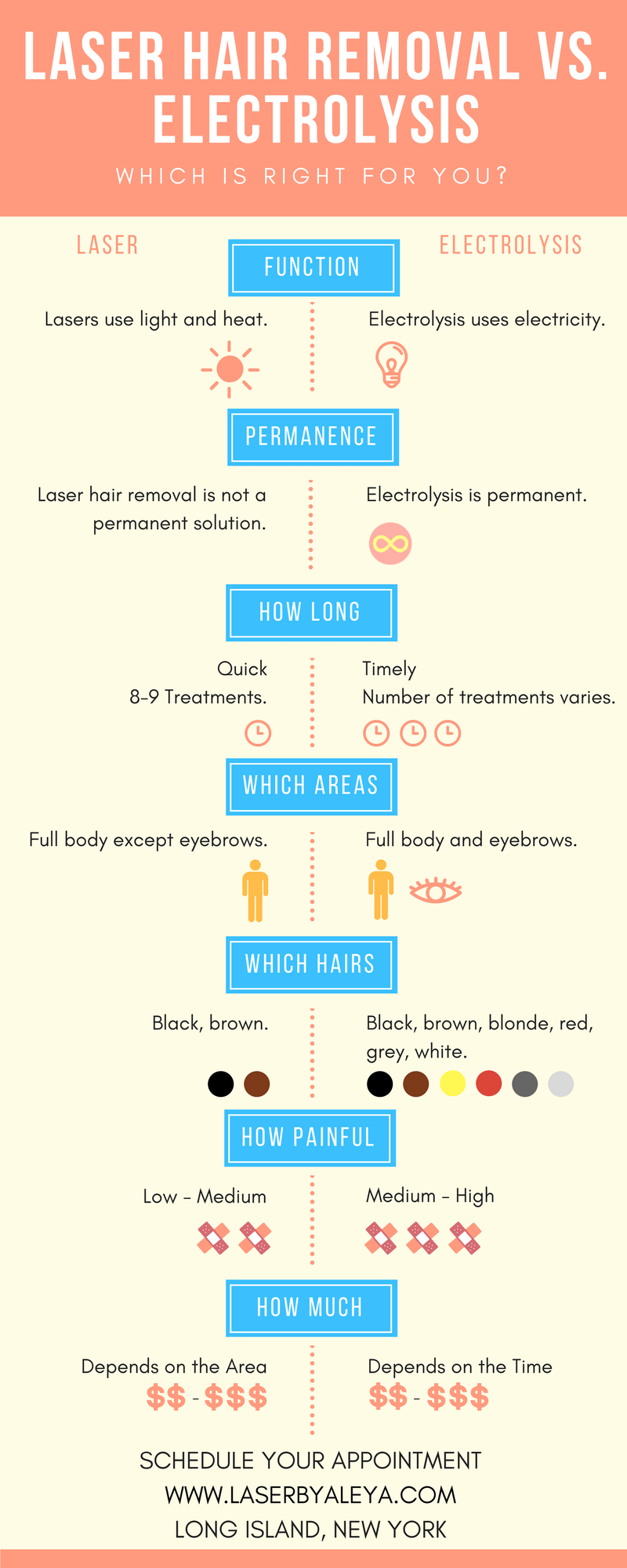Laser Hair Removal vs. Electrolysis: What’s the Difference?

Laser Hair Removal and Electrolysis are two of the most effective forms of hair removal. While these two techniques share several things in common, they share some critical differences. It is imperative to know what these differences are so you can make the best choice for your body.
Laser Hair Removal vs. Electrolysis
Neither is better or worse than the other. Rather, the best choice depends on the individual and their unique needs. In order to know if laser hair removal or electrolysis is the right choice for you, you should know all the facts.
How Does It Work?
Laser Hair Removal: Like the name suggests, laser hair removal uses beams of light, so the force at work is heat. Heat is applied topically, targeting the hairs in a certain area at once.
Electrolysis: Electrolysis, on the other hand, uses small bursts of electricity to remove hair. The Electrolysis probe goes directly into the follicle, targeting single hairs at a time. Read more on how electrolysis works here.
How Permanent is it?
Laser Hair Removal: Laser hair removal is not a permanent solution. While it will significantly reduce the hair for prolonged periods of time, there is no guarantee that the hair will not grow back. This is because the light from the laser damages the hair follicles, but it does not completely destroy them.
Electrolysis: Electrolysis is the only permanent hair removal solution. Each individual hair is targeted and electrocuted, destroying the follicles ability to regrow hair. For-e-ver.
How Long Does it Take?
Laser Hair Removal: Laser hair removal does not take very long to complete. Depending on the size of the area being targeted, it can last anywhere from a few minutes to an hour.
Electrolysis: Conversely, electrolysis is time consuming because it goes by one hair at a time. For people of Middle Eastern, Greek, Italian, or Indian descent, the hairs tend to be a more stubborn, resulting in longer treatments. However for men and women of all ethnicities, the process will most likely take a long time so it is important to be patient.
How Many Treatments Does it Take?
Laser Hair Removal: Generally speaking, laser hair removal takes eight to nine treatments to see the desired results. However, since laser does not permanently remove the hair, many people choose to have follow-up and maintenance treatments further down the road.
Electrolysis: When it come to electrolysis, it is tricky to pin down exactly how long it will take. There are many factors that influence the results, including what has been done to the hairs in the past, and frequency of treatments. At the beginning the electrolysis hair removal process, it is suggested to get treated on a weekly or bi-weekly basis.
What Areas Can Hair Removal Be Performed On?
Laser Hair Removal: Laser hair removal can be performed nearly everywhere on the body, including Underarms, Arms, Legs, Back, Stomach, Bikini, Feet, and even the Face. At Laser by Aleya in Long Island, however, your technician will not perform laser hair removal on the bikini area for men, or on eyebrows because the laser can be extremely dangerous to the eyes.
Electrolysis: Electrolysis can be performed on all of the same areas as laser, including Face, Underarms, Arms, Legs, Back, Stomach, Bikini, Feet, and even eyebrows.
What Kind of Hair Does it Work on?
Laser Hair Removal: Laser hair removal works best for certain skin types and hair types. This includes men and women with dark, thick hair. Typically, people with lighter skin have the best results, but the Diode laser also works well on individuals with darker skin pigment. Unfortunately, laser hair removal is ineffective on red, blonde, grey, and white hair.
Electrolysis: Electrolysis can work on hairs on all areas of the body and of all types. Hairs can be thick, thin, or a combination. Additionally, it works on red, blonde, white, grey, brown, and black hairs. For this, most people are good candidates for electrolysis hair removal.
How Painful is It?
Laser Hair Removal: Like all aspects of laser hair removal, this depends a lot on the individual and the area that is being treated. Overall, laser hair removal causes slight discomfort, but the pain is very manageable. For people with a low pain tolerance, you can ask your technician for a topical numbing solution. There are also some precautionary measures you can take to make the treatments more comfortable for you.
Electrolysis: Again, while this depends on the pain tolerance of the individual, electrolysis is reported to be overall more painful than laser hair removal. This is largely because it is a long process, sending a small electric burst to each singular hair follicle. Like laser, there are many factors that contribute to the level of pain, and you can try to manipulate them in order to make your experience more comfortable. However, if permanent laser hair removal is of importance to you, you should not let pain be a discouraging factor.
How Much Does it Cost?
Laser Hair Removal: Price varies greatly by salon and the quality of treatment you are receiving. At Laser by Aleya in Long Island, we only use the highest quality apparatuses, operated by trained and experienced technicians. Find a full price list by body part here.
Electrolysis: Electrolysis pricing is not based on body part, but by time. This is how most salons structure the treatment pricing for electrolysis since each individual requires a different amount of time based on the amount of hairs in the area. Find the pricing timetable here.
How To Choose Between Laser Hair Removal and Electrolysis?
There are many factors that need to be considered when choosing between laser hair removal and electrolysis, including amount of hair, tattoos, skin conditions, and more. There are plenty of resources available to help you decide if you are a good candidate for one or the other.
If you’re still unsure which method is best for you, schedule a consultation at Laser by Aleya in Long Island and explore your options.



![Top Bikini Laser Hair Removal Styles [Illustrations & FAQs]](https://www.laserbyaleya.com/wp-content/uploads/2025/06/bikini-laser-hair-removal-hero-image-updated-768x469.png)